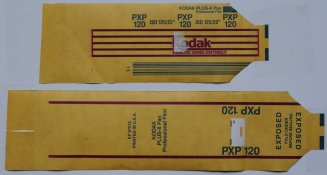A friend of my wife´s appeared the other day with a Hasselblad 500C/M that her mother had been left and wondered if I could value it. In the A12 back was an exposed roll of Kodak Plus-X that we developed only to find it badly damaged by time and a severe light leak. The only image that could be seen was an out of focus shot of a woman in what appeared to be an 80’s hairdo and sweater (there was some discussion if it was a woman or a man but we settled on woman by two votes to one).
It would be interesting if the film could be, not dated, but placed in a period of time and I wonder if Kodak changed the graphic style on the backing paper of Plus-X at any point between -78 (when the A12 back was produced) and 2011 when production of Plus-X ceased and if the backing paper can be attributed to a specific period. It’s not really important but just out of curiosity.
It would be interesting if the film could be, not dated, but placed in a period of time and I wonder if Kodak changed the graphic style on the backing paper of Plus-X at any point between -78 (when the A12 back was produced) and 2011 when production of Plus-X ceased and if the backing paper can be attributed to a specific period. It’s not really important but just out of curiosity.




